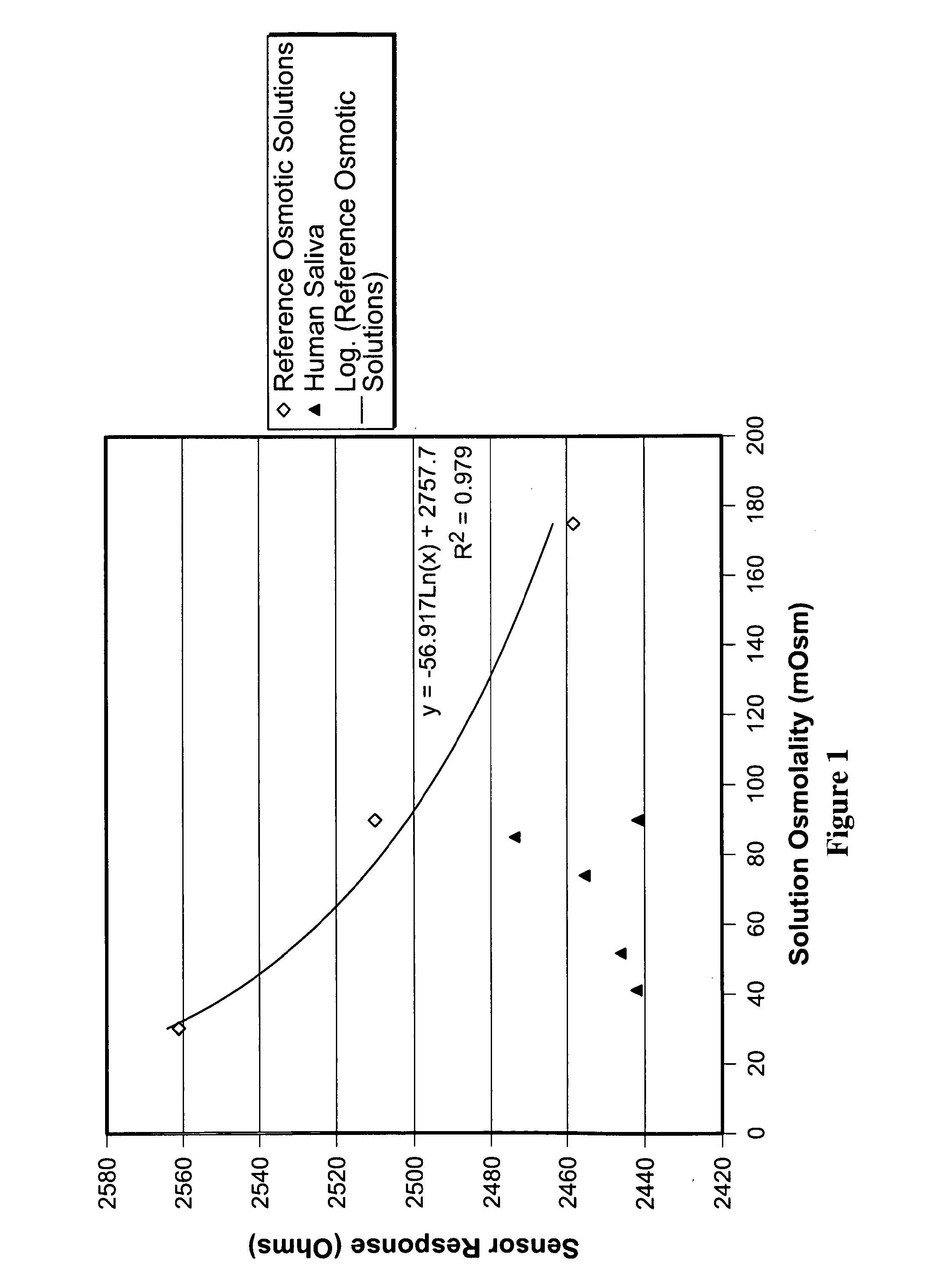Methods, system and devices for analyzing a biological fluid sample following ion exchange
a biological fluid and ion exchange technology, applied in chemical methods analysis, chemical analysis using chemical indicators, instruments, etc., can solve the problems of difficult to analyze saliva bulk properties, difficult to obtain and validate the results obtained from biological sample analysis,
- Summary
- Abstract
- Description
- Claims
- Application Information
AI Technical Summary
Benefits of technology
Problems solved by technology
Method used
Image
Examples
example 1
Measurement of Osmolality of Untreated Saliva Samples as Compared to Standard Methods of Sample Preparation
A. Measurement of Osmolality of Untreated Saliva Samples
[0107]Initial attempts to obtain osmolality data from saliva using a hydrogel sensor was met with unstable osmolality readings and inconsistent results. Attempts to determine the osmolality of human saliva, led to sensor measurements which were slow, inaccurate, not reproducible, and elevated when compared to sensor measurements of saline solutions of similar osmolality (as determined by freezing point depression osmometry).
[0108]More specifically, when a hydrogel sensor was placed directly into an unprocessed saliva sample, the response of the sensor would take 15 minutes to over an hour to achieve a rate of change of cantilever resistance less than 0.1 Ohm / minute. Repeat measurements of identical saliva samples yielded inconsistent results, particularly if separated by different samples.
[0109]The cantilever resistance is...
example 2
Measurement of Osmolality of Saliva Samples Treated with Ion Exchange Resins
[0116]Further studies were carried out to determine if an accurate and consistent determination of saliva osmolality could be achieved by sample treatment with an ion exchange resin prior to measurement of osmolality using a hydrogel sensor.
[0117]It was eventually determined that treatment of saliva with certain ion exchange resins results in an accurate and consistent determination of saliva osmolality using hydrogel sensors consistent with results obtained using the freezing point depression method.
[0118]In carrying out the studies, sensing hydrogels were immersed in a dilute (0.05M) sodium hydroxide solution for one hour prior to use.
[0119]The results showed that treatment of saliva samples with various cation exchange or chelating resins at a final concentration of from about 0.001 meq exchange capacity / ml to about 0.05 meq exchange capacity / ml for a time period of from about 20 seconds to about 5 minute...
example 3
Measurement of Osmolality of Tear and Blood or Serum Samples
[0136]Tear film is readily obtained by the capillary collection method and can be treated with an ion exchange resin prior to analysis and then spotted onto the microcantilever sensor. A convenient tear film osmometer was constructed by coating microfiber cation exchange resin onto a microcantilever sensor. The sensor is then directly placed on the outer surface of the cornea to measure tear film properties including osmolality.
[0137]The osmolality of whole blood and serum are commonly measured using a freezing point or vapor pressure osmometer. Whole blood (100 uL) was obtained using a finger stick lanced and spotted directly onto a sensor prepared as described hereinabove and coated with IEF powder (as shown in FIGS. 11A and B). The sensor reached an equilibrium resistance value within 3 minutes corresponding to 308 mOsmol.
PUM
| Property | Measurement | Unit |
|---|---|---|
| pH | aaaaa | aaaaa |
| freezing point | aaaaa | aaaaa |
| vapor pressure | aaaaa | aaaaa |
Abstract
Description
Claims
Application Information
 Login to View More
Login to View More - R&D
- Intellectual Property
- Life Sciences
- Materials
- Tech Scout
- Unparalleled Data Quality
- Higher Quality Content
- 60% Fewer Hallucinations
Browse by: Latest US Patents, China's latest patents, Technical Efficacy Thesaurus, Application Domain, Technology Topic, Popular Technical Reports.
© 2025 PatSnap. All rights reserved.Legal|Privacy policy|Modern Slavery Act Transparency Statement|Sitemap|About US| Contact US: help@patsnap.com



